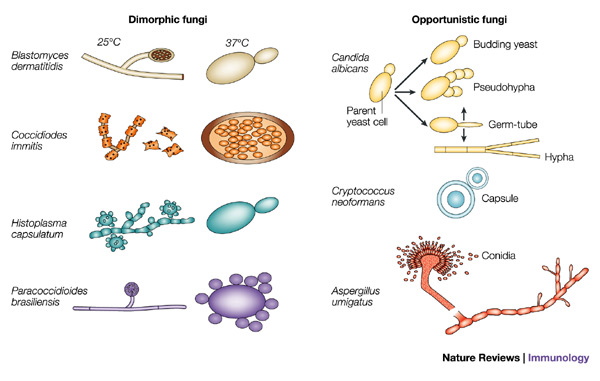What are really really bad molds?
All molds and yeasts are allergens and possible pathogens!!!
The book "Atlas of Clinical Fungi. G. S. de Hoog et al. 2000. CBS Netherlands" described thousands of fungal molds and yeasts, which are reportedly isolated from animal or human hosts published in scientific journals.
Medical mycology textbooks mainly include those common but pathogenic molds and yeasts:
Aspergillus fumigatus; Coccidioides immitis; Paracoccidioides braziliensis; Histoplasma capsulatum; Blastomyces dermatitidis; yeast Candida albicans; yeast Cryptococcus neoformans; Dermatophytes, which infect skin and nails.
> Any molds that can grow in 37C are potentially human pathogens.
Because within human body, the temperature is 37C, a mold to be a pathogen, has two conditions to meet: to tolerate a 37C temperature and to resist or evade the human immune system.
> All BSL-3 and some BSL-2 molds!
· Paracoccidioides brasiliensi (BSL-3 mold);
· Blastomyces dermatitidis (called Blasto, BSL-3 mold);
· Coccidioides immitis (called Cocci, Valley fever agent BSL-3 mold));
· Histoplasma capsulatum (called Histo, BSL-3 mold);
· Penicillium marneffei (the only Penicllium species rated as BSL-3 mold);
· Aspergillus flavus (producer of mycotoxin aflatoxins);
· Aspergillus fumigatus (the No.1 pathogenic mold in clinical cases);
· and other Zygomycetous molds Rhizopus and Mucor species (black bread molds).
> Opportunistic yeast pathogens: Candida albicans and Cryptococcus neoformans
· opportunistic yeast Cryptococcus neoformans (may cause fungal meningitis);
· another opportunistic yeast Candida albicans (the widespread yeast pathogen);
> Dimorphic fungi
Dimorphic fungi are meant that a fungus can take both morphological forms: in filamentous moldy form or a more-or-less yeast form, upon different culture conditions. Most fungal pathogens do take yeast forms once they are invaded human tissues.

